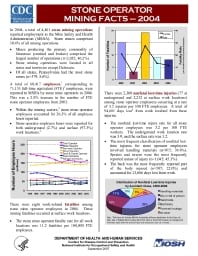Mining Publication: Stone Operator Mining Facts - 2004
Original creation date: September 2007
Authors: National Institute for Occupational Safety and Health
NIOSHTIC2 Number: 20032737
Pittsburgh, PA: U.S. Department of Health and Human Services, Public Health Service, Centers for Disease Control and Prevention, National Institute for Occupational Safety and Health, DHHS (NIOSH) Publication No. 2007-170, 2007 Sep; :1-2
In 2004, a total of 4,401 stone mining operations reported employment to the Mine Safety and Health Administration (MSHA). Stone mines comprised 30.4% of all mining operations. Mines producing the primary commodity of limestone (crushed and broken) comprised the largest number of operations (n=2,032; 46.2%). Stone mining operations were located in all states and territories except Delaware. Of all states, Pennsylvania had the most stone mines (n=379; 8.6%). A total of 68,417 employees, corresponding to 71,153 full-time equivalent (FTE) employees, were reported to MSHA by stone mine operators in 2004. This was a 2.8% increase in the number of FTE stone operator employees from 2003. Within the mining sectors, stone mine operator employees accounted for 26.3% of all employee hours reported. Stone operator employee hours were reported for both underground (2.7%) and surface (97.3%) work locations. There were eight work-related fatalities among stone mine operator employees in 2004. These mining fatalities occurred at surface work locations. The stone mine operator fatality rate for all work locations was 11.2 fatalities per 100,000 FTE employees. There were 2,309 nonfatal lost-time injuries (77 at underground and 2,232 at surface work locations) among stone operator employees occurring at a rate of 3.2 injuries per 100 FTE employees. A total of 94,681 days lost from work resulted from these injuries. The nonfatal lost-time injury rate for all stone operator employees was 3.2 per 100 FTE workers. The underground work location rate was 3.9, and the surface rate was 3.2. The most frequent classification of nonfatal lost time injuries for stone operator employees involved handling materials (n=915; 39.6%). Sprains and strains were the most frequently reported nature of injury (n=1,045; 45.3%). The back was the most frequently reported part of the body injured (n=507; 22.0%) and accounted for 23,666 days lost from work. In 2004, 89 cases of occupational illnesses were reported to MSHA by stone mine operators.This compares to 96 cases in 2003. Joint, tendon, or muscle inflammation or irritation accounted for the most frequently reported occupational illnesses (n=35; 39.3%). In 2004, there were 16 cases of hearing loss or impairment reported to MSHA (18.0% of all illnesses). This compares to 27 cases (28.1%) reported to MSHA in 2003. Other illnesses reported included dermatitis (n=9; 10.1%) and heat stroke, sunstroke, heat cramps, etc. (n=9; 10.1%).

NIOSHTIC2 Number: 20032737
Pittsburgh, PA: U.S. Department of Health and Human Services, Public Health Service, Centers for Disease Control and Prevention, National Institute for Occupational Safety and Health, DHHS (NIOSH) Publication No. 2007-170, 2007 Sep; :1-2
- Coal and metal/nonmetal mining facts - 2008
- Coal and Metal/Nonmetal Mining Facts - 2008 (HTML)
- Coal Contractor Mining Facts - 2001
- Coal Contractor Mining Facts - 2002
- Coal Contractor Mining Facts - 2003
- Coal Contractor Mining Facts - 2004
- Coal Contractor Mining Facts - 2005
- Coal Contractor Mining Facts - 2006
- Mining Fact Sheets
- Rib Falls: A Major Ground Control Issue